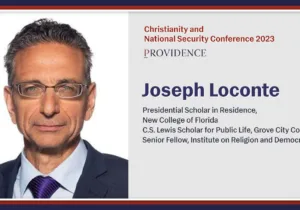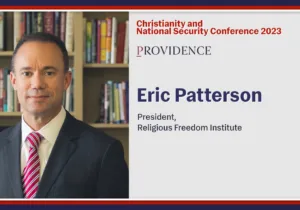What did a man, who encountered both Gandhi and Hitler, say about the prospects of non-violence? The comparison is startling, but at least one journalist covered both persons: William Shirer. Hitler is regarded by many as the most concrete incarnation of devilry ever seen. Dr. E. Stanley Jones said that “one of the most Christlike men in history was not called a Christian at all.”1 He was Gandhi, a Hindu. For Christians, this is an eye-popping and controversial statement, yet there emerges from this juxtaposition a serious question: what is the role of non-violence, and more specifically pacifism, in the world today? Reinhold Niebuhr, while admiring Gandhi, was also very critically aware of the strengths and limits of non-violence. Pacifism was even heretical, according to Niebuhr’s standards. So, what did Shirer have to say about these two men who, in moral terms, could not be farther apart? And how does this inform our ideas about non-violence and war?
On February 23, 1904, William Shirer was born. Though best known for his book The Rise and Fall of the Third Reich, he also produced a biography of the father of modern India, Gandhi, A Memoir. Shirer came away from meeting Gandhi deeply moved, writing that the experience taught him the comparative equality of world religions. He also believed, however, that there might be a limitation to Gandhi’s non-violence.
There is a commonsense approach to this debate. Just as we evaluate the weather each day, putting on a warmer coat or bringing an umbrella in response to the meteorological circumstances, we must also be able to evaluate the political climate to gauge if non-violence is practicable. Reading weather conditions is certainly easier, but two of the most famous advocates of non-violence, Gandhi and Dr. Martin Luther King Jr., were also aware of this question.
First, what did Gandhi say about the conditions necessary for non-violence? Gandhi called his non-violent method satyagraha, or “truth force.” It struck a non-violent blow to the opponent’s conscience, attempting to reform them. Gandhi spelled out the criteria for the success of satyagraha:
- The Satyagrahi should not have any hatred in his heart against the opponent.
- The issue must be true and substantial.
- The Satyagrahi must be prepared to suffer till the end of his cause.2
Gandhi did not adamantly proceed with non-violence under all circumstances. He called off satyagraha campaigns when violence erupted as an unintended consequence. Gandhi even fasted for the victims of such violence. The Mahatma could also be very pragmatic about the time and place for non-violence, famously saying, “Where there is a choice between cowardice and violence, I would advise violence.”3 Gandhi’s understanding of the capacity for non-violence could be quite nuanced.
Dr. Martin Luther King Jr. was inspired by Niebuhr’s Moral Man and Immoral Society. There Niebuhr wrote of non-violence that, “if persisted in with the same patience and discipline attained by Mr. Gandhi and his followers,” it would allow African American boycotts to achieve some success and greater racial justice.4
Dr. Martin Luther King Jr. was inspired by both Gandhi and Niebuhr, and did, of course, lead a very successful, though arduous, civil rights campaign. Yet he also reflected upon some of the strengths and limitations of non-violent campaigns. He wrote that “long years of experience” taught him four criteria that contributed to the success of non-violence:
- Non-violent demonstrators go into the streets to exercise their constitutional rights.
- Racists resist by unleashing violence against them.
- Americans of conscience in the name of decency demand federal intervention and legislation.
- The administration, under mass pressure, initiates measures of immediate intervention and remedial legislation.5
Examining these two lists, a few interesting points emerge. Firstly, both men humbly omit the status of their own charismatic leadership. Non-violent campaigns involve intense risk and need great motivation. An inspirational leader and motive should be a constant companion to their effort. Secondly, King’s criteria are more conscious that the public, as well as the government, must be capable of responding with a just, moral reaction. In short, there had to be a sufficient moral barometer, a climate that was responsive to the non-violent plea. Non-violence had to be able to impact the top political ranks.
Did Gandhi’s non-violence stand a chance against Hitler? Far removed from what was going on in Germany, Gandhi at one point thought that it did. The Jews and British might, he once suggested, use non-violence as a tool against Hitler.6 These are some of the most difficult and least realistic words to read coming from Gandhi. Shirer, who had covered Hitler and had a firmer measure of him, was more discerning that Gandhi’s methods could not appeal to the heart of a heartless man.7 Rajmohan Gandhi, the grandson of the Mahatma, also recorded that Hitler had said he would just shoot Gandhi, had he faced him.8 This is a point of departure for realism. Human nature can be good, but it also resists good norms and is sometimes shockingly morally numb. Non-violence is an ideal as valuable to Christians as it is to Hindus or other world citizens, but it has its time and place.
The lesson to be learned here is neither to belittle non-violence nor to exalt exclusively the just war tradition, but to keep in mind that both have their time and place. Indeed, though peace is the ideal, as Gandhi expressed well, the real world will rarely leave such accord unmolested. What we fight for is the political and moral climate that allows for nonviolence more regularly, as King and Gandhi both exemplified, and to keep the tanks and soldiers in waiting for the worst of political weather. Any moral belief system, whether Christian or Hindu, must have an ideal that inspires its adherents. Yet it must also have a real measure that high ideals are always hard to implement and often only approximated in the real world. Political climates, like the weather, are never fixed, and our tools of justice must be aptly chosen to meet them just as the choice of umbrella or snow jacket. This is what William Shirer would say, the man who came close to the 20th century’s greatest devil and saint.
Bibliography:
1. Louis Fischer, Gandhi, His Life and Message for the World, (Mentor Books/ New American Library, New York, 1982), 130.
2. Mohandas K. Gandhi, edited by Shriman Narayan, The Selected Works of Mahatma Gandhi. (India, Ahmedabad: Navajivan Publishing House1968), volume 6, 186
3. Louis Fischer, Gandhi: His Life and Message for the World, 89.
4. Reinhold Niebuhr, Moral Man & Immoral Society: A Study in Ethics and Politics, (Louisville, Westminster John-Knox Press, 2001), 254.
5. Martin Luther, King Jr, edited by James M. Washington, The Essential Writings and Speeches of Martin Luther King Jr., (New York: Harper Collins, 1986), 127.
6. Yogesh Chadha, Gandhi: A Life, (New York, John Wiley and Sons, 1997), 363, 369-370.
7. William Shirer, Gandhi: A Memoir, 211.
8. Rajmohan Gandhi, Gandhi: The Man, His People, and the Empire, (Los Angeles, University of California Press, 2008), 400.







 Sponsor a student for Christianity & National Security 2024
Sponsor a student for Christianity & National Security 2024